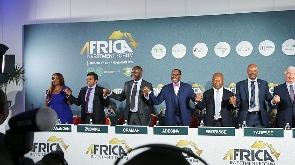Development finance institutions in Africa have cautioned governments against using countries’ natural resources to back infrastructure loans, as it amounts to mortgaging their future to creditors. Instead, they want states to explore public-private partnerships to finance their development projects.
While addressing a press conference in Abidjan, Côte d’Ivoire during the African Investment Forum, executives of eight multilateral finance institutions in Africa said most states in the continent had become heavily indebted and the volatility of the global economy was making their debt situation worse, hence the need to go slow on borrowing to explore cheaper ways of financing development.
The multilateral development banks are working with wealth funds to have them finance infrastructure development.
Repaying infrastructure loans well
Led by the African Development Bank (AfDB), the organiser of the African Investment Forum, they vouched for the continent’s creditworthiness, noting that Africa has done well in repaying its infrastructure loans.
Dr Akinwumi Adesina, the AfDB president, noted that Africa has the lowest default rate on infrastructure loans in the world, at 5.5 per cent. The biggest defaulter, according Moody’s Analytics, is Latin America at 12.9 per cent, followed by Asia at 8.8 per cent, Eastern Europe (8.6 per cent), North America (7.6 per cent), and Western Europe (5.9 per cent).
“We must begin to see infrastructure as an asset to us. The issue of the risk of investment in Africa is exaggerated. The issue is not risk but the risk-adjusted return and how you manage risk,” Dr Adesina said.
“So, we must not be de-risking bias risk. In other words, perception risk is not what we should be de-risking. But we don’t want countries taking too much debt to do infrastructure, it will only make the debt situation worse for them. So they need to open up the space to the private sector and I believe strongly we must have, at the very minimum, public-private partnerships: allow the private sector in energy, transport, medical, infrastructure and so on. Let the private sector space be expanded for infrastructure.”
Build Africa’s capacity
The lenders have committed to collaborate with African governments to build the continent’s capacity for agriculture, renewable energy and manufacture of electric cars.
On agriculture, they are going to support special agro-industrial processing zones across Africa to turn agriculture into a wealth sector.
On electric cars, the banks are looking to fund value chains for the minerals making parts and batteries such as nickel, cobalt and lithium.
“We will put our resources together, technical resources in terms of technical assessment, our project development capacity here, our co-financing capacity here with others to be able to develop value chains for the batteries on the continent and attract investors to manufacture the cars,” Dr Adesina said.
Solar energy
On energy, the institutions plan to invest $20 billion to build 10,000 megawatts of solar across 11 countries, which will provide electricity for 250 million people.
“There is overconcentration of solar panel manufacturing in the world. So as Africa tries to maximise and optimise renewable energy -- we have 11 terawatts of solar -- so we decided collectively, that we will support designing, support and planning for the manufacturing of polysilicon and solar panels,” Dr Adesina said.
The institutions are AfDB, Africa50; Africa Finance Corporation, Africa Export-Import Bank, Development Bank of Southern Africa, European Investment Bank, Islamic Development Bank and Trade and Development Bank.
They are also pushing the International Monetary Fund (IMF) to channel the special drawing rights (SDRs) cash through them for use in infrastructure development.
“The world is going through all kinds of challenges right now. The big one, of course, is climate change, Covid-19, the war in Ukraine and what it has done in terms of energy costs, in terms of food prices, inflation… we have a big financing gap for infrastructure and there's not a whole lot of money on the table to support developing countries. One of the ways to actually deal with this is the special drawing rights,” Dr Adesina said.
The IMF in 2021 issued $650 billion of special drawing rights, which is the highest it has ever issued. But Africa only got $33 billion out of that amount.
The multilateral lenders have been making a case for the SDRs to be given to them to fund growth and poverty reduction programmes on the continent.
“I commend the efforts of IMF for their resilient trust that they have, which is great. However, the SDR transactions will be one-to-one while multilateral development banks like ourselves can actually invest the SDR money. Now, for us, $1 of SDR will become $4 for the country. So, if you got $10 billion, that becomes $40 billion; $20 billion becomes $80 billion. So that's the leveraging impact. That is very important for the SDR to complement the efforts of the IMF.
“And I think that this is important because as we look at global challenges, we have to ask ourselves: What is the best way to optimise the global financial architecture starting from the IMF down to multilateral financial institutions? If we leverage the SDR four times, that is money we can use to recapitalise and support the Development Bank of South Africa, the Africa Finance Corporation, Africa50, Trade Development Bank, Islamic Development Bank and others.”
But they called for transparency and accountability in the expenditure of infrastructure finance.
“It's not just how much money you're putting into infrastructure; it’s the efficiency of that expenditure.”
Africa News of Tuesday, 8 November 2022
Source: theeastafrican.co.ke

















